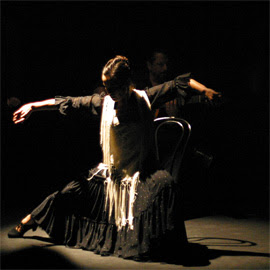
The love I have for you I cannot deny My mouth is watering I just can’t help myself.
--”Chan Chan” by Compay Segundo
Am I dreaming or on the moon? Havana at night is surreal. I’m not prepared for the darkness, the decay lit only by florescent lights casting an eerie gray glow over the crumbling arcades and torn up sidewalks. There is no neon, no advertising save for the dim Viva la Revolucion! billboards, no commercial signs, few streetlights, only the occasional low watt gray porch light. Havana is the darkest city I’ve ever been in.
The ghostly figures I see moving among the shadowy ruins might be waltzing to Prokovief in Disney’s Haunted Mansion. But going about their business in the dark are the colorful, vibrant, infinitely practical Cuban people moving to the Cuban rhythms heard everywhere in the streets and in their daily lives. If Fidel is the father of modern Cuba, music is the mother of its people.
Being in Havana now feels like I’ve journeyed back through the decades to not only another place, but another time, an island Brigadoon, an eroded Atlantis found.

This is the land of pirates and buccaneers, of Conquistadors and Castro, of castles and kings and exotic Communism. A tropical paradise that some thought to be the Garden of Eden, with a bloody history that includes American presidents, the Mafia, and the search for the Fountain of Youth. And all of this is in a five-hundred-year-old country only ninety miles from the U.S.!
But I didn’t come to get involved in history or politics. I came here for the timeless pleasures of music and dance.
I knew when I saw “The Buena Vista Social Club” that I had to come to Cuba. The old American cars cruising under the spray from the waves crashing against the Malecon to the song “Chan Chan.” That scene made me cry, and travel all this way to explore why I was affected so much by a piece of popular music.
The basis for my trip is with a group to teach the Cubans Argentine tango and for them to teach us to dance salsa. Rather ironic for a native Californian of mixed European ancestry to teach Latinos a Latin dance. But for Cubans, Argentine tango is as foreign as West-Coast Swing.

 I stay at the Hotel Sevilla in Habana Vieja, the heart of the tourist center. Built in 1908 and now owned jointly by Cuba and France and recently restored, its large public spaces and guest rooms are plain but comfortable and the Roof Garden on the ninth floor is absolutely stunning with old world grandeur. Although Havana is a UNESCO World Heritage Site, it’s only the tourist hotels that are currently being restored with foreign money.
I stay at the Hotel Sevilla in Habana Vieja, the heart of the tourist center. Built in 1908 and now owned jointly by Cuba and France and recently restored, its large public spaces and guest rooms are plain but comfortable and the Roof Garden on the ninth floor is absolutely stunning with old world grandeur. Although Havana is a UNESCO World Heritage Site, it’s only the tourist hotels that are currently being restored with foreign money.Like other world capitals, with the Coliseum, Westminster Abbey, the Empire State Building, or the Eiffel Tower, Havana, too, is its architecture. But the general disintegration of it’s once-grand Spanish Colonial mansions, now with flags of colorful laundry on the rusted baroque balconies, only adds interest to the history-starved Norte Americano’s vacation with the plus of lots of photo ops. We can go to Europe if we want to see the golden arches nestled among ancient edifices.
Havana satisfies our nostalgia for days gone by, for what we’ve lost. Here we are young forever, here we can see the world that perhaps our parents inhabited. And so very much better than a trip to Main Street U.S.A., Havana is real, a romantic, mysterious, two-faced and forbidden time-warp. We visitors murmur to each other, looking at pastel palaces turned into tenements, imagine what it was like before!

Our group of American, Canadian, Argentinian and Cuban dancers meet daily either in the hotel or at the Union Arabe across the street on the Prado, where giant loudspeakers constantly blast salsa, the blanket term for son, mambo, Afro-Cuban, timba, chachacha, rumba and other forms of Cuban music. At first the dance exchange is a struggle for everyone; the visitors can’t move their hips sufficiently in the salsa classes, and the Cubans can’t not move their hips as the tango requires.
to be continued...













































